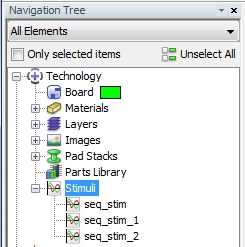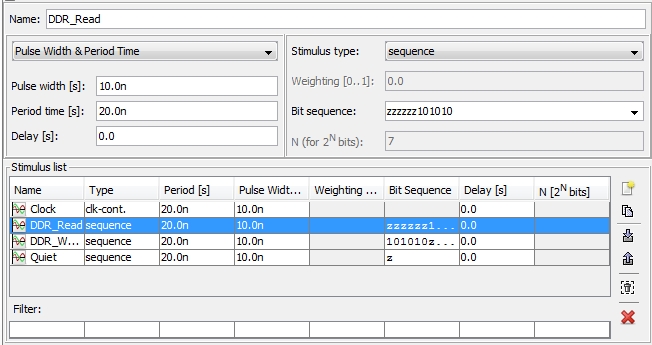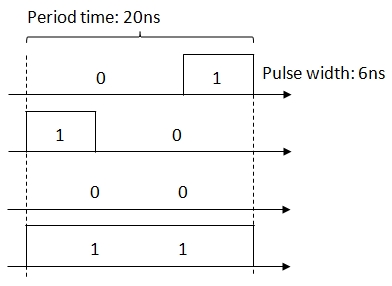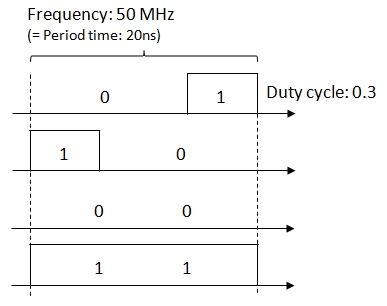

0: low voltage state (0 Bit)
1: high voltage state (1 Bit)
z: idle state
 Stimuli as shown in the figure below:
Stimuli as shown in the figure below:

The Stimulus Editor is divided in an upper and a lower part. In the upper part the Name of the specific stimulus can be defined. In addition, the general Stimulus type can be specified and how the Stimulus shall be described regarding Period Time or Duty Cycle. The lower part provides the data table including the defined Stimuli. The columns of the table change according to the settings in the upper part.

Pulse Width & Period Time:
Period Time is the time frame during two sequent states (Bits) have to be executed. Pulse Width defines the time of the high voltage state (1 Bit). Delay enables the user to shift the complete bit sequence by a certain time.

Duty Cycle & Period Time:
Period Time is the time frame during two sequent states (Bits) have to be executed. Duty Cycle defines the time of the high voltage state (1 Bit) as a fraction of the Period Time. Delay enables the user to shift the complete bit sequence by a certain time.

Duty Cycle & Frequency:
Frequency is the inverse of the Period Time and defines the time frame during two sequent states (Bits) have to be executed. Duty Cycle defines the time of the high voltage state (1 Bit) as a fraction of the inverse of Frequency (=Period Time). Delay enables the user to shift the complete bit sequence by a certain time.

clk-cont: provides a continuous sequence of alternating bits 0 1 0 1 0 1 ...
sequence: allows a free definition of a bit sequence. The state z turns the active output pin to an receiving input pin. The dialog accepts the definition of a z-state within a not completed unit cycle (e.g.: 01 1z zz z0 10 ...). But it is recommended to complete an active unit cycle before defining one ore more pairs of z-states (e.g.: 01 11 zz zz 10 ...)
random: provides a random bit sequence. The Weighting field controls the average number of 0 and 1 Bits. A weighting of 50% means the sequence will include an equal average of 0 and 1 Bits. A weighting of 100% means the sequence will include only 1 Bits and a weighting of 0% means there will be only 0 Bits.
pseudo random bit sequence: provides a standardised bit sequence typically used for signal integrity analysis. The number of pulses can be given in the N (N2 bits). The first N pulses are always 1 Bits.
Create new stimulus
Duplicate stimulus
Import stimulus from a Stimulus Library file
Export stimulus to a Stimulus Library file
Delete all unused stimuli: delete all stimuli which are not used by any I/O device.
Delete selected stimuli
Clock: a stimulus of type clk-cont (see Stimulus type above)
DDR_Read: a typical bit sequence for reading
DDR_Write: a typical bit sequence for writing
Quiet: a sequence of passive states